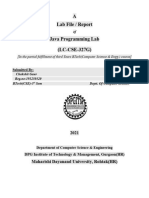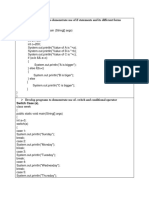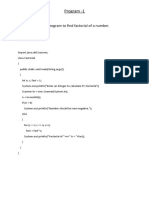0% found this document useful (0 votes)
5 views22 pagesVivek Java
The document outlines a practical file for a Bachelor of Technology course in Computer Science & Technology at St. Andrews Institute of Technology & Management for the session 2024-2025. It includes various Java programming tasks such as implementing data structures, exception handling, multithreading, and creating GUI applications. Each task is accompanied by source code and expected outputs.
Uploaded by
ankitghamdan106Copyright
© © All Rights Reserved
We take content rights seriously. If you suspect this is your content, claim it here.
Available Formats
Download as PDF, TXT or read online on Scribd
0% found this document useful (0 votes)
5 views22 pagesVivek Java
The document outlines a practical file for a Bachelor of Technology course in Computer Science & Technology at St. Andrews Institute of Technology & Management for the session 2024-2025. It includes various Java programming tasks such as implementing data structures, exception handling, multithreading, and creating GUI applications. Each task is accompanied by source code and expected outputs.
Uploaded by
ankitghamdan106Copyright
© © All Rights Reserved
We take content rights seriously. If you suspect this is your content, claim it here.
Available Formats
Download as PDF, TXT or read online on Scribd
/ 22























































































